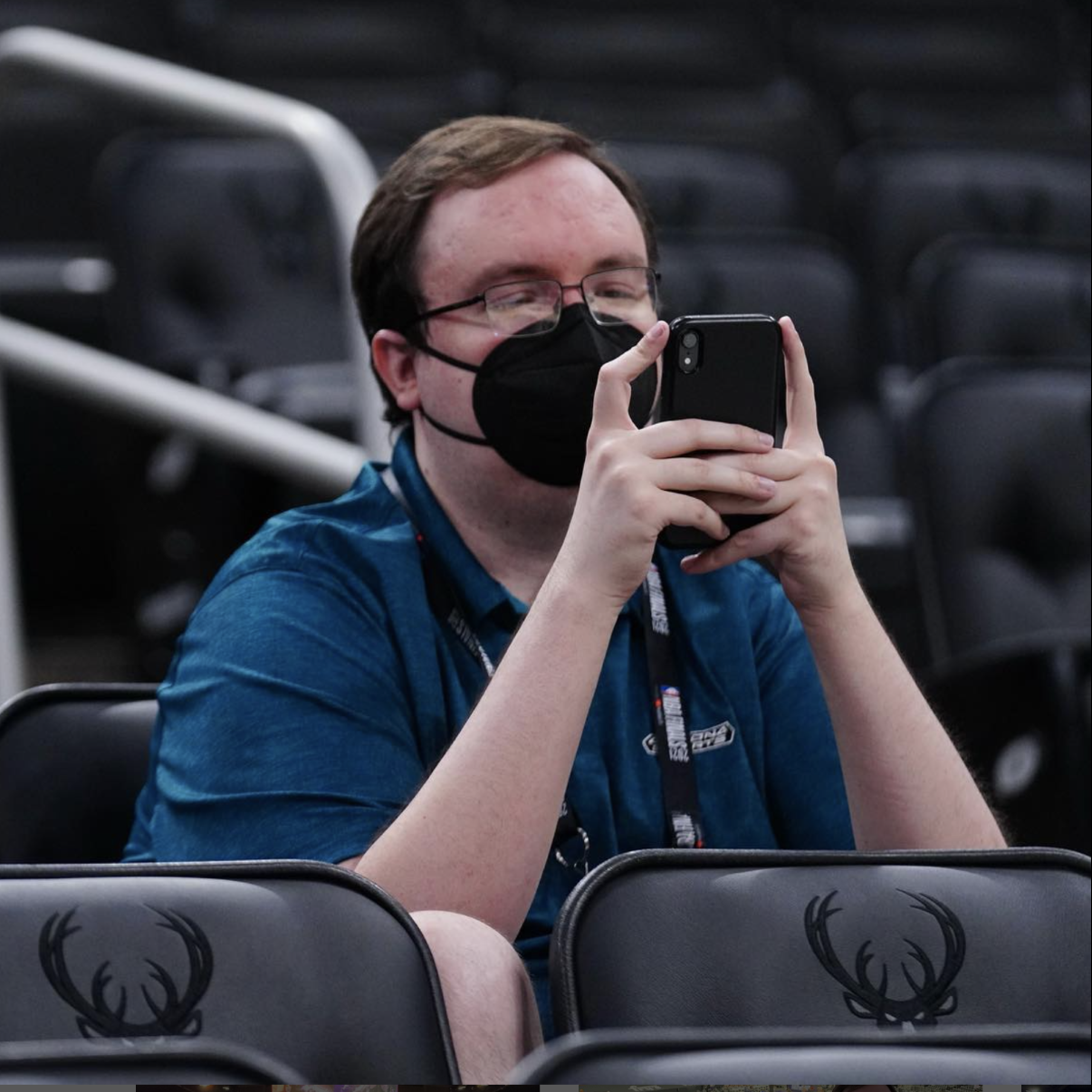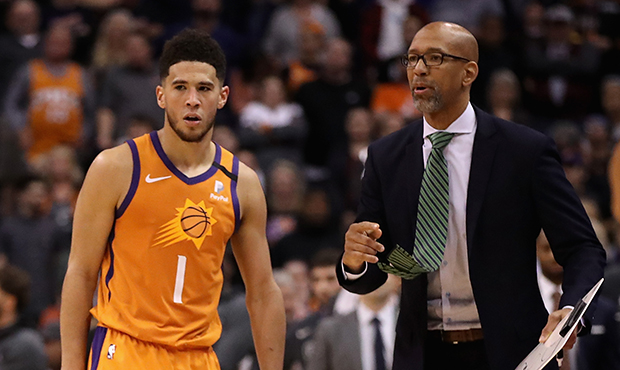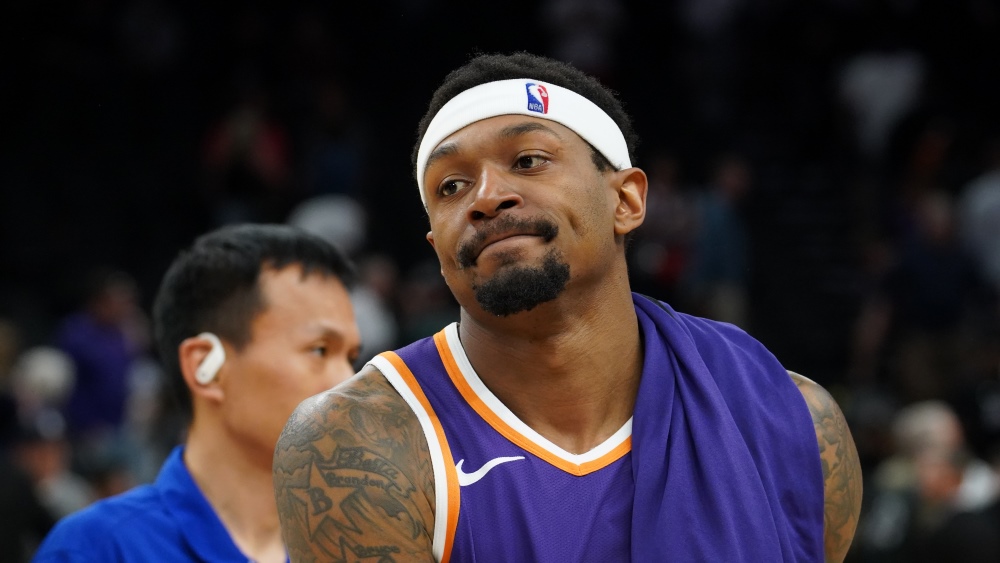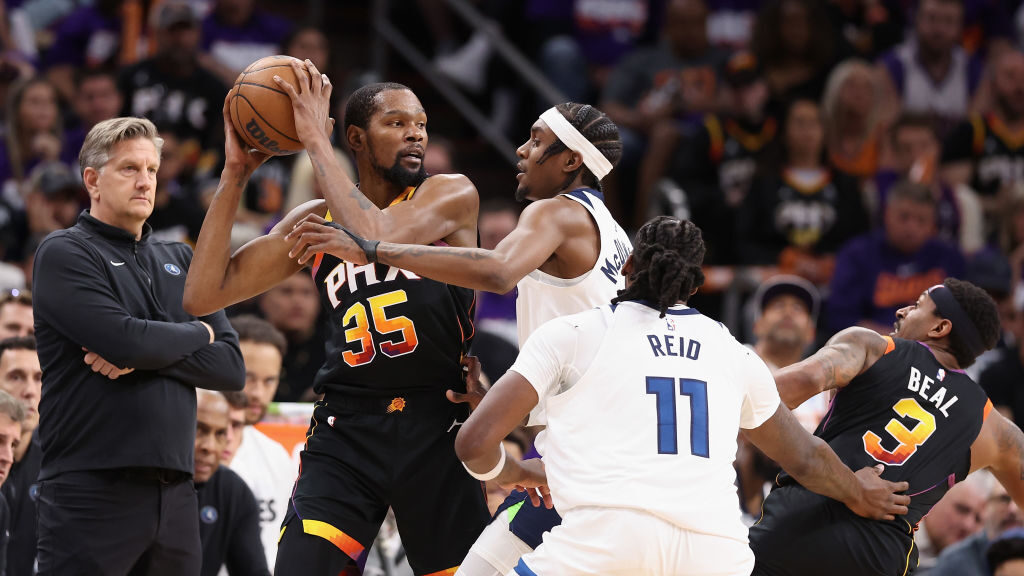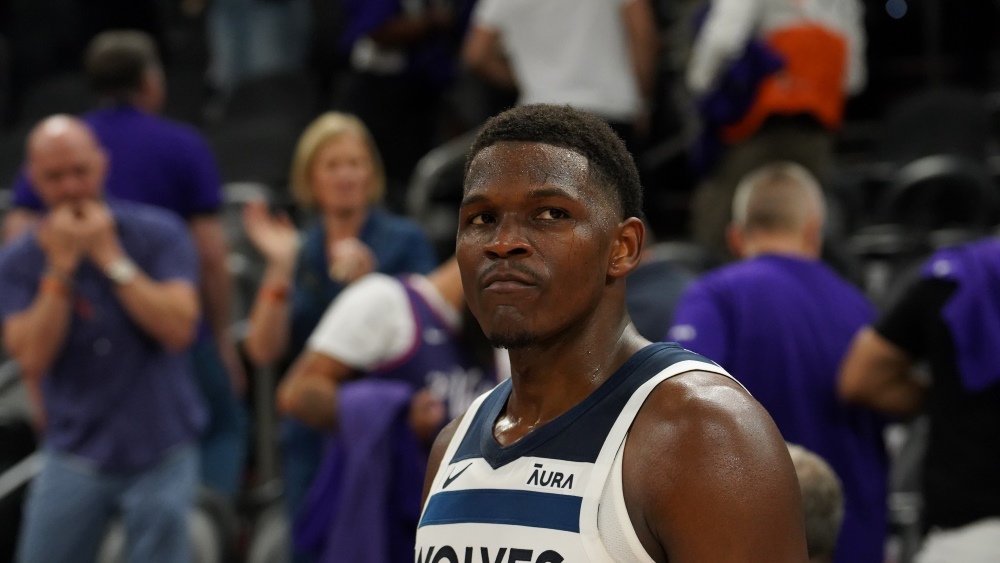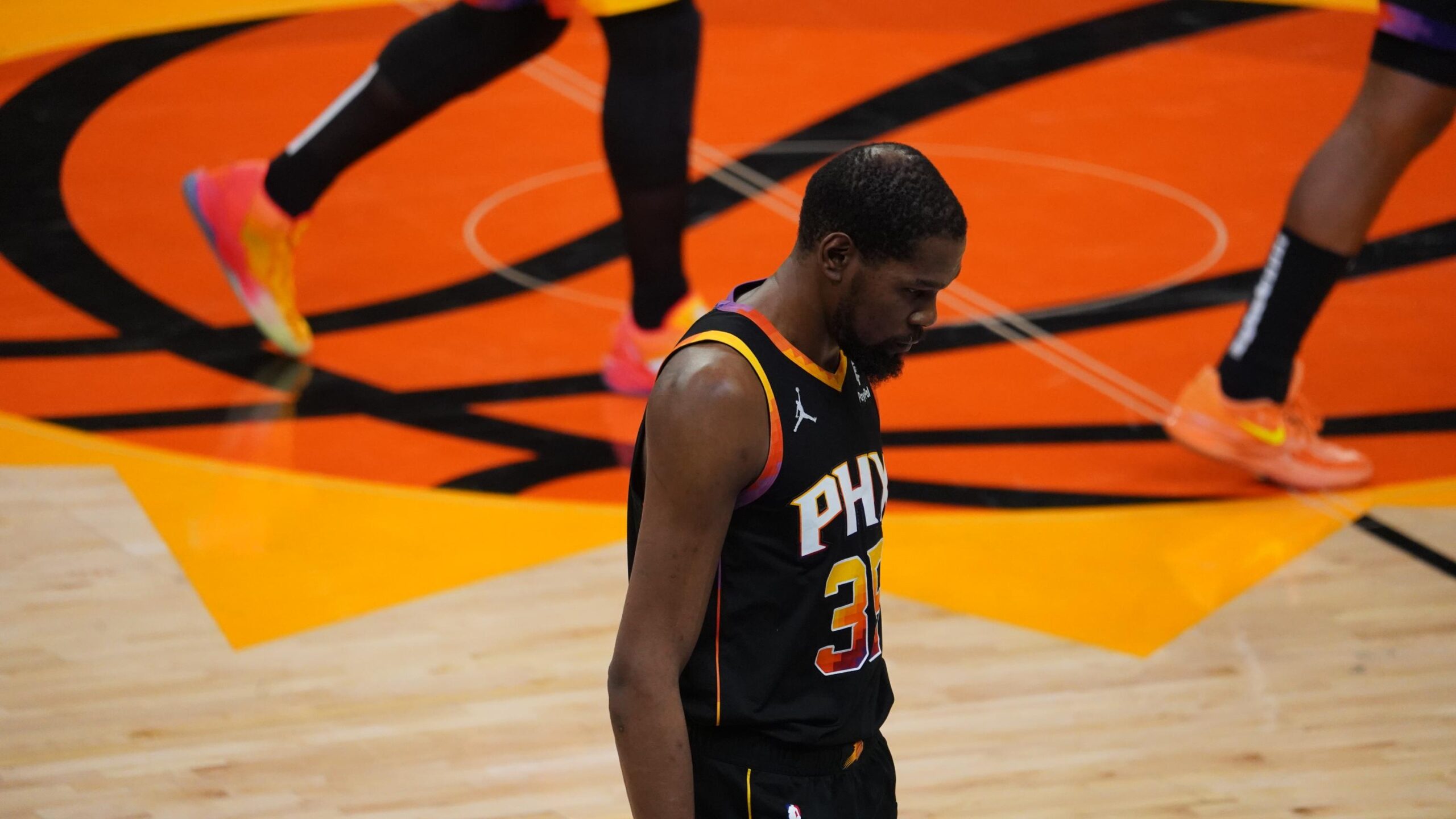Grading the Suns’ offseason: Lots of layers to Cam Johnson draft-day trade
May 29, 2020, 6:02 PM
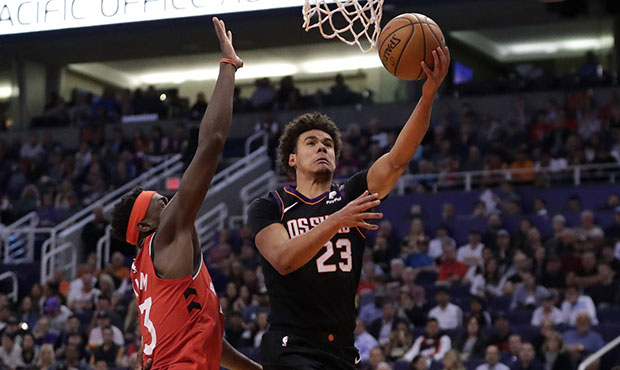
Phoenix Suns forward Cameron Johnson (23) shoots over Toronto Raptors forward Pascal Siakam during the second half of an NBA basketball game Tuesday, March 3, 2020, in Phoenix. The Raptors won 123-114. (AP Photo/Matt York)
(AP Photo/Matt York)
With the NBA suspended due to the coronavirus, the future of this season is in doubt for the Phoenix Suns. Even if the season were to continue, the Suns are 65 games in and certain declarations can be made about the moves they made before the 2019-20 season.
Empire of the Suns will take a look at the most significant moves from last offseason, the first in which general manager James Jones and senior VP of basketball operations Jeff Bower were in charge on a permanent basis. Both Kevin Zimmerman and Kellan Olson will be giving their own grades, and we’ll also post the results from a Twitter poll.
This time, it was the move trading down in the 2019 NBA Draft.
Kellan Olson: B-
Kevin Zimmerman: B-
Twitter grades: B – 41.6%, C – 38.1%, A – 12.9%, D/F – 7.6%
June 22, 2019: Phoenix Suns trade the No. 6 overall pick in the 2019 NBA Draft (Jarrett Culver) to the Minnesota Timberwolves for the 11th selection (Cam Johnson) and power forward Dario Saric
Let’s go from the simplest layers of this trade to the most complex, because there are quite a few.
Jones had a whole lot of work to get done last summer, a challenging grocery list of building an adequate roster with a starting point guard, power forward and additional pieces beyond that they didn’t have.
It was almost an impossible ask to expect the two starting-quality boxes to be checked, but Jones got it done, and the only way he was going to was with a move like this one.
When it was first reported Saric was the prize for trading down, it took a few minutes to figure out the number one reason why until you saw Saric only had a salary of $3.4 million.
Jones had to flip and barrel roll through hoops to squeeze in enough cap space for some of his other desires, shipping out T.J. Warren and Josh Jackson to have enough money for Ricky Rubio, Aron Baynes and Ty Jerome.
He wasn’t going to have enough gusto to maneuver through more to fit a power forward, and acquiring Saric on the books for $1.5 million less than what Frank Kaminsky signed for was the equivalent of just calmly walking across the finish line.
Because of that and the player Saric is, there was an extremely slim chance he was going to swing this deal one way or the other. He was going to land somewhere on the spectrum between competent starting four and rotation big, and getting that for his price was the biggest win.
Saric basically was what he has been.
He was inconsistent throughout the year, but made an impact enough and produced. His per-36 numbers (in 24.8 minutes a game) of 14.6 points, 8.6 rebounds and 2.7 assists on 46.2/34.1/83.2 shooting percentages line up right around his career averages.
While his three-point shot wasn’t as good as it needed to be, the Suns’ demeanor and play on the court showed that they trusted Saric on the court. He was making the right pass, was aggressive to score or go off the dribble and was one of the team’s top help defenders.
The Suns had a trial year with Saric as a restricted free agent to see if he is worth paying.
Ultimately, from a roster construction standpoint, Saric and just about any four-man who isn’t a reliable shooter and plus athlete can’t fit.
We shouldn’t go down that rabbit hole, though, because the grade on this trade was always going to come down on how right Phoenix was about 1) the options they passed up taking at Nos. 6 and 11 and 2) Johnson himself.
For the most part, they were pretty right!
The two areas where Johnson was going to live up to backend-of-the-lottery value were his shooting being at a legitimate top level and having a basketball smarts/athleticism combination high enough to survive against NBA wings.
The shooting was awesome from the jump, and that’s not as common as you would think, even for the best shooters ever in college basketball.
Johnson met the hype.
Even with rookies who come into the NBA known for shooting, it takes 'em a while to get comfy with a quick trigger. Cam Johnson is already there.
1st clip – stepping back
2nd clip – sees space, dribbles back
3rd clip – couple feet back over LeBron
4th clip – jab step pic.twitter.com/vcADZZdeDJ— Kellan Olson (@KellanOlson) November 15, 2019
He shot 39.7% from deep on 4.7 attempts per game. He became the fifth rookie in league history to meet that volume and efficiency, per Basketball-Reference.
By the end of the season, it has become clear that Johnson’s mentality is the main reason why he has this elite skill.
After scoring a career-high on his birthday in a close loss, Johnson was visibly distraught talking to the media, even when it was 45 minutes after the game ended. When asked if there were any of his misses that were sticking in his head, he immediately replied with four of them and recited when and where all four took place.
That was a moment to remember if Johnson winds up being a real player in this league.
As for everything outside of that, Johnson has been a scale-breaking standout in terms of the intangibles and basketball IQ categories that Jones time after time repeated he was looking for in players last offseason.
“He’s not a guy that I’m concerned with,” Monty Williams said of Johnson all the way back in October, a theme that was even echoed in training camp that Johnson was rapidly picking things up.
Johnson defensively in his rookie year played like a guy who saw the criticism of him on that end and the tape from North Carolina that spotlighted his inability to stay connected to the play.
He put in the work on that end.
As we’ve discussed with Devin Booker the past few years, so much of defense is just effort and knowing how to use that effort. Johnson getting over the screen, holding his hands up for the overhead pass and then keeping an eye on the ball-handler to swipe at the pocket pass is that to a T.
Johnson is going to get overpowered by most fours and even threes. His athleticism concerns stem from his initial burst and pop, where laterally at the point of attack he can struggle. That’s also a concern in creating separation with the ball, to the point where those wings can beat him there too.
But if he keeps working like he did as a rookie, he can healthily be anywhere below average to good on that end, depending on his improvement trajectory. That’s a long way of saying he doesn’t look like a guy that will be a serious liability on defense, which I would have bet not being the case on draft night.
His development trajectory should be mentioned, as he’s already 24 years old. We’d be talking about him a whole lot differently if he was five years younger like some players in his class, but he’s not, so an outlook on his ceiling is obviously capped to some extent. Still, it’s a good bet to make he can at least be a positively-contributing role player, and maybe even a starter if he keeps getting better.
So that’s Johnson himself. The value here, however, extends beyond him.
As someone who liked Johnson in the late first round, my utter disbelief at the selection was more about how the Suns picked someone who has to play most of their minutes at small forward when they already have Mikal Bridges and Kelly Oubre Jr.
There’s an undeniable fork in the road at finding all three of them enough minutes.
Bridges should get at least 30 and Oubre averages near 35. That’s 17 minutes of positional overflow to even get those two their run, so where does Johnson go?
Due to injuries and Bridges’ rough start to the season, we didn’t need to get the answer in year one, and it’s still a question.
I’m gonna illustrate the full picture here.
Looking at the Suns addressing their two biggest needs and desires for this upcoming offseason, here’s a preview of a potential minutes allocation next season.
(As I’ll note here in a minute, this is assuming they get/retain a backup center and add a new starting-caliber power forward and a combo guard. They plan to do that.)
Center: Deandre Ayton (34), Mystery 5 (14)
Power forward: Mystery 4 (30), Bridges (11), Johnson (7)
Small forward: Oubre (35), Johnson (10), Bridges (3)
Shooting guard: Booker (30), Bridges (12), mystery combo guard (6)
Point guard: Ricky Rubio (27), mystery combo guard (15), Booker (6)
Some notes on this:
– Obviously, the easiest fix here is the Suns fully committing to starting Oubre and Bridges together, which is a starting lineup that outscored teams by over 20 points per 100 possessions this season. That’s not out of the question, but the Suns do want to get that starting-caliber four if they can this offseason. If they don’t, though, that makes it easy enough to solve this problem. Let’s assume they do, as I said.
– The basic math here is that there are 96 forward minutes. Oubre played 35 last year, and assuming they bring in that four, we will put that individual down for 30. That’s 65 and leaves only 31 to fill in all of Johnson’s minutes and some of Bridges’ as well. Ignore who plays where with who. More about the numbers.
– Bridges’ defensive versatility is the biggest key. In this alignment, he’s playing nearly half of his 26 minutes at two-guard because he can defend four positions. That opens up Johnson at forward.
– A potential tweak here is not having a set-in-stone reserve center and having the ability to go small with that mystery four-man at times to open up some more minutes at power forward. Those fours are tough to find, and that four’s minutes being closer to 25 a night or 35 is huge for flexibility too.
– Williams said during the league’s hiatus that he wants to run more “Point Book.” I went light on it with six minutes, for now.
– This estimate has Bridges at 26 minutes. That’s probably low. He’s proven to be one of the three most consistently impactful players for the Suns once he got out of his funk.
This was an elongated exercise to show that even if we take a few liberties, we get Johnson to 17 minutes. Those will fluctuate based on the game, but it’s going to be difficult to get him around 24-28 minutes a game.
Now, Oubre’s contract is up at the end of next season. Jones could have been galaxy-brained enough to see the future of not only a two-year deal of Oubre, but being unable to retain him. So, Johnson is a safety valve of sorts there. The Suns, however, should do everything possible to bring back Oubre if he continues to play the way he has.
Where we arrive is that there’s just not enough value at No. 11, no matter the draft, to take a guy that will very likely be your third-best player at a position that requires some rotation gymnastics to get him to even 20 minutes.
The loss in value for the pick also has to do with taking Johnson at No. 11 on its own, when Phoenix could have absolutely got him in the late teens and probably as far back as the early twenties.
But who did they pass up on him for?
The biggest whiff so far appears to be Miami’s Tyler Herro at 13th overall. While his stats don’t pop, the player himself does when you watch him. Herro could have been the Suns’ third guard right away and the hope would have been to develop him as a combo that would play with either Ricky Rubio or Booker. Did we mention that he idolizes Booker too?
Brandon Clarke, the No. 21 selection, is not so shockingly a useful piece in a NBA rotation already for Memphis, and that’s at a spot where Clarke could have played both center and power forward minutes for Phoenix this year.
As for No. 6, where the Suns were originally at before they made the trade, there are some names worth mentioning too.
Chicago’s’ Coby White (seventh overall) has had flashes as a scoring guard, Cam Reddish (10th overall) pieced some things together in the last two months for Atlanta, and while Culver’s All-Star potential didn’t flash much at all in year one, his high floor, particularly on defense, showed in Minnesota.
The overlying point here, though, should be that there isn’t one clear guy rated far and above the other. Most would take Herro over Johnson, but it isn’t as much of a clear and obvious separation as you would have thought.
To review, Saric was a good addition at a role they would not have been able to get at that price anywhere else. Johnson was a reach, but looked the part of a rotation-level wing in his first year, which is something you’ll take at No. 11. Most importantly, the names they passed on don’t look like they’ll severely come back to bite them at the moment, especially if Johnson winds up being a starting-level wing.
Johnson showing he has a decent chance of becoming that in year one makes this a good overall move as a whole for the Suns, even if they are slotted in their roster alignment to not be able to maximize him.

